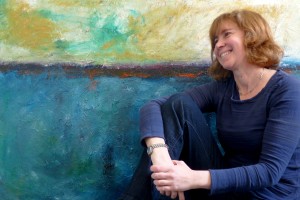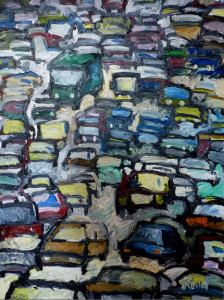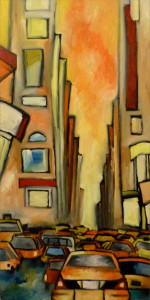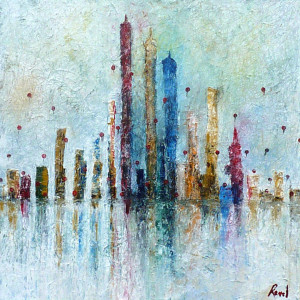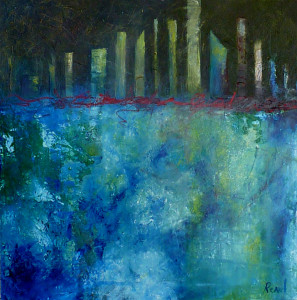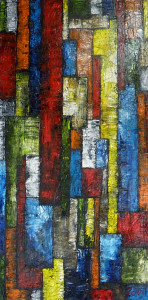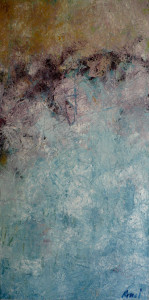Rien ne se perd,
Rien ne se crée,
Tout se transforme!*
— Antoine Lavoisier 1743-1794
(Note on Renel’s studio wall)
*Nothing is lost,
Nothing is created,
All is transformed!
French Canadian artist, Renel Plouffe, throws herself into the moment of artistic creation, glorying in the act of painting. Her passion is readily visible. Surfaces are roughly, almost violently, textured. Pigment is applied lavishly in color combinations that range from an elemental clash of primaries to an almost mystically subtle variation in shades of analogous colors. Her art is a profound and primary means of communication for her. It is an art that does not make compromises.
“I break down the subject to its visual essentials—light, dark, color, tone, movements, and textures. Each canvas is absorbed by color brushstrokes, and a textured background. The result is a reflection of my true essence and outlook on life.”
Creating series of paintings around a common theme is central to the way Renel approaches her art. She has used a variety of such themes over the course of her career, systematically exploring ideas that have meaning for her. At any given time she is mining two or three such thematic areas. The paintings in her current show focus on two: ‘city’ and ‘water’.
“I’m a city girl,” she says. “You know when you go in a big city and everything is moving—I just love the electricity in the air. I used to fill my city pictures with people and cars. That was how I presented what I really love about urban life, the craziness and the energy of the city.”
Traffic 20×16 Oil Heure de Pointe 30×15 Oil
“When I paint something like ‘Traffic,’ I feel like I’m telling a story. In this painting you can feel the tension and the anger, but you have to smile because it’s just ridiculous. I mean everyone is angry and the panel van is just happy to be there and that makes everything over into a joke.”
However, her city ‘theme’ is a continually evolving and has changed in significant ways in the work she has done for her latest show. “I don’t put people in my city paintings any more” she notes, “It’s just buildings, which I suppose is sort of silly in a way, since even at night it’s impossible to have a city without people. I used to do buildings with people in them. I stopped. I don’t know why.”
Esperance 30×30 Oil
I think the city represents my more rational side and yet I love the seeming randomness of nature and the sense freedom it gives me.”
Another theme she is currently working with is ‘water’. “My nature painting is more minimalist,” she says. ” Painting water is peaceful. For me it’s almost like meditation. I’m very loose when I do it and I’m very free. I don’t think so much. I play more with the texture as compared to line. For me nature is color and texture and subtle revelation. I think the city represents my more rational side and yet I love the seeming randomness of nature and the sense freedom it gives me.”
Eclosion 30×15 Oil
She makes no secret of the fact that the themes and subjects she chooses reflect where she is in her life mentally and emotionally. “I’m always struggling to have balance in my life. I can be pretty extreme in the way I approach things. Right now, I think I need these two types of images. My art is the mirror of who I am. Maybe I seek balance by moving back and forth between these sorts of images. However, for some reason my themes of ‘water’ and ‘city’ are coming together stylistically. I suppose to some extent the categories are beginning to merge.”
“Painting is my speech, my playground, my reality”
Born in Gatineau, Canada, in the province of Quebec, Renel first pursued psychology and mathematics upon graduating from secondary school. However, her early and powerful love of art soon won out over her mathematical and scientific gifts and she changed direction. “My parents always traveled a lot. We spent time in Europe and went to many, many museums. They had a big interest in art. My mother painted and from when I was a little girl, I did too.”
She received her degree from the University of Hull (Canada) in fine art and graphic design, while also doing additional work to gain certification in both 2D and 3D animation. She then moved to Montreal, a city known for its art scene, to launch her career. Starting work with a company that made video games, she soon discovered the truth about an industry many believe to be glamorous. “It’s not what people think,” she says. “What you have to understand, is the gaming and movie industries are very, very difficult, tough, worlds. And they are a man’s world. You work a lot of hours and compared to the U.S., the wages are low. I didn’t have a life.”
Yet, Renel was unafraid of the hard work. Despite her long hours and difficult schedule, she found a way to further her artistic development, choosing to attend evening classes at the Ecole des Beaux-Arts. For two years she took painting classes from the Russian artist, Nikolai Kupriakov. “Kupriakov was very strong in teaching the fundamentals. And he really showed how to deconstruct and interpret a subject and I found that fascinating.”
“I can, be pretty extreme in how I approach things,” she says, with little appreciation of her understatement.
She liked Montreal and was making progress, becoming established with Montreal galleries and doing commercial design work, when her husband’s company transferred him to Houston, TX. “That was a very strange time for me. In Montreal I’d been working 60-65 hours a week and had gotten to know a lot of people in the art world there—all that was suddenly gone.” Unable to work in the United States without a work visa, she threw herself into a full time schedule of painting. “I found a good dealer and was selling well. I was doing a lot of work with the figure, particularly with nudes.” Over the course of the next four years she established herself as both a fine artist and, when her work visa was granted, as a commercial artist in the Houston area. Then her husband was transferred again, this time to Chattanooga, TN.
Nuit sur Ville 30×30 Oil
Embracing a schedule that would crush a less driven artist, Renel is at her easel every morning at 7:15 when she returns from taking her twin daughters to preschool, and she works until around 1:00 in the afternoon. With her family fed and her children in bed, she often returns to her highly organized garage studio to work, “until 1:00 or 2:00 in the morning or until I find myself getting impatient with what I’m working on. I can, be pretty extreme in how I approach things,” she says, with little appreciation of her understatement.
Renel always starts a painting in the same simple way. “I just start. I don’t do preparatory sketches. That’s not as aimless as it sounds. I almost always work in series around central themes so I have a good idea where I want to go with a painting. I have an image in my mind when I start. Frankly, I see the painting I want to do in my mind and I just do it.” And since she works in series, she is usually working on more than one picture at a time, switching between them.
As she works, Renel focuses her attention on two aspects of painting that are of particular concern to her: surface texture and color.
“Paintings should be like people. People are multi-layered and only give up their layers and secrets over time. A painting should do that. I paint in layers and then scratch or otherwise work my way back to expose those layers to a greater or lesser extent.”
“When I started out, I used to do very flat almost liquid surfaces on my paintings. Then I began playing with texture about ten years ago, and I loved the depth it gave my work. Often I put a color down, paint over it, and then remove part of the surface layer to reveal an underlying contrasting color. I use brushes when I paint, of course, but I also paint a lot with the palette knife, which I also use to scratch the dry or partially dry surface for additional texture. I love a rough and rich texture on my paintings. I’ve even developed a method of stressing the surface with braided wire of varying gauges that I have unbraided at the end. The wire strands make fine scratches on the surface. I scratch into both wet and dry surfaces, though working into dry surfaces gives a finer, more subtle effect. Usually I work into the surface to create texture but there are times when I use texturing agent such as acrylic medium mixed with sand to alter the paint itself. I also use modeling paste. Really, I’m willing to do anything to get the surface texture I’m looking for.”
Color is also of crucial importance to her art. She always starts with a set of colors she will use and her choices are intuitive. She sees the colors in her mind and, “I just naturally know which ones I’ll be using. It’s rare for me to do a painting without at least an accent in red. It’s my signature color, I suppose. Red for me is really intense. I love red. My dad loved red. He always bought red roses for my mom. “ Sometimes she seeks dramatic color combinations, juxtapositions of complements of richly colored pigments. At other times the effects are more subtle, but always her color is dramatic and personal.
Facade 24×12 Oil Evasion 30×15 Oil
With her ever evolving themes, where do her ideas for new work come from? “I keep images—photos, things I cut out of magazines—really anything that I find visually interesting. If I thing they will really be useful, I paste them on the wall. These images are not there to copy, but they spark ideas. I look at them all the time and they suggest things to me. But when I start painting, they are of no use to me, by then the image I want is in my head—a palette of colors, the textures—all that I imagine before I start.”
“Painting is a way of expressing myself and communicating with others. And when I paint, I can stop the conscious stream of thought in my mind and access a subconscious flow. That’s the only time that happens for me. I paint because I need to paint.”
Does she have any sense of what lies next in her artistic journey? She greets the question with a classic French shrug of her shoulders. “I don’t know,” she says. “I never really know. It goes with what I’m feeling and what I’m living in my life. If I look at my art from 15 years ago it’s completely different, but I was a completely different person then. My art of the future will depend on who I become as a person.”
